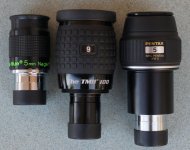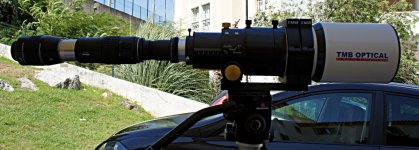DRodrigues
Well-known member
I'm not the only one thinking on this as Can post http://www.birdforum.net/showthread.php?t=153877 shows.
After seeing the TMB 9mm 100º http://www.astronomics.com/main/pro.../4LTTSBRXCV069JKSSJ74CS9K41/product_id/TMB209 I was waiting for a 5mm to give a try (I need 1.25" size for my Optolyth 100).
Meanwhile TeleVue released the Ethos-SX 3.7mm 110° http://www.televue.com/engine/TV3_page.asp?id=20&Tab=EP_ETH-03.7 that went directly to my wish to test list at cr-telescopes at www.pt-ducks.com - if there was a 5mm version I might be tempted to ordered it but my bad experience with the Radian 4mm showed me that in a 630mm birding scope I'm pushing the limits too much...
Remembered to write this message because I just noticed the new Nikon NAV HW 12,5mm 102º http://www.apm-telescopes.com/nikon-nav-hw-125mm-okular_proinfo_52783.html that could be a new EDG eyepiece that would turn the Nikon EDG scopes more interesting, if the tag prices were not "astronomical" as the astro versions... Nikon don't have a wide field zoom as Leica or Swarosvky, neither a 20-75x zoom as Zeiss. A eyepiece of this sort would bring more "light" to the EDG scope line...o
After seeing the TMB 9mm 100º http://www.astronomics.com/main/pro.../4LTTSBRXCV069JKSSJ74CS9K41/product_id/TMB209 I was waiting for a 5mm to give a try (I need 1.25" size for my Optolyth 100).
Meanwhile TeleVue released the Ethos-SX 3.7mm 110° http://www.televue.com/engine/TV3_page.asp?id=20&Tab=EP_ETH-03.7 that went directly to my wish to test list at cr-telescopes at www.pt-ducks.com - if there was a 5mm version I might be tempted to ordered it but my bad experience with the Radian 4mm showed me that in a 630mm birding scope I'm pushing the limits too much...
Remembered to write this message because I just noticed the new Nikon NAV HW 12,5mm 102º http://www.apm-telescopes.com/nikon-nav-hw-125mm-okular_proinfo_52783.html that could be a new EDG eyepiece that would turn the Nikon EDG scopes more interesting, if the tag prices were not "astronomical" as the astro versions... Nikon don't have a wide field zoom as Leica or Swarosvky, neither a 20-75x zoom as Zeiss. A eyepiece of this sort would bring more "light" to the EDG scope line...o







